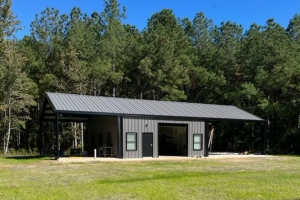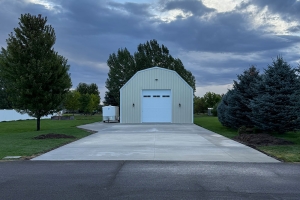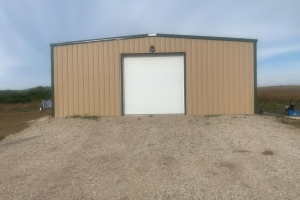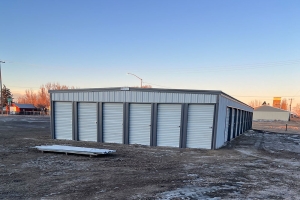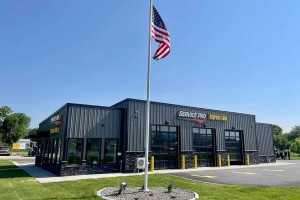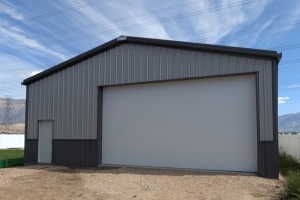Scalable Data Center: Smart Approach To Growth And Expansion
May 7, 2025 | Data Center
Scalability is essential for any growing business, especially when it comes to data centers. As your company expands, so does your need for a flexible infrastructure. A scalable data center can evolve with your business, providing the room to add capacity without costly or time-consuming renovations.
Steel buildings are the ideal solution for this adaptability. Known for their strength and versatility, steel structures can be easily modified or expanded to meet the growing demands of your data center. With steel, you get a durable, long-lasting foundation that supports both current needs and future growth.
Core Features Of An Expandable Data Center
When designing a scalable data center, several key features ensure your infrastructure can grow alongside your business. These components offer the flexibility, efficiency, and capacity needed to meet future demands while minimizing disruptions during expansion. Here are the core features that make a data center truly adaptable:
- Modular design: Modular design uses separate, flexible units that can be easily added or reconfigured, allowing your data center to expand as your business needs grow.
- Pre-engineered steel structures: These are custom-built, factory-made components that simplify construction. They provide a strong, adaptable foundation, making future expansions quick and cost-effective.
- Energy-efficient cooling systems: Efficient cooling systems help reduce energy costs and support long-term growth by maintaining optimal temperatures for expanding data center infrastructure.
- High-density computing support: Steel buildings can offer a spacious, open layout to accommodate high-density computing equipment, ensuring your data center can support growing technological demands.
Optimizing Data Center Size For Scalability
Scalable data centers can easily expand as business needs grow, allowing for seamless adjustments in size and capacity. Unlike traditional data centers, which often require significant renovations or costly rebuilds to accommodate growth, scalable data centers are built with future expansion in mind.
Right-sizing your data center is essential to ensure it can handle current demands while scaling efficiently. This approach ensures you’re not overbuilding, incurring unnecessary costs, or underbuilding and risking capacity shortages.
By properly scaling your data center, you can reduce long-term expenses. A well-sized, adaptable facility allows you to avoid costly retrofits and offers more predictable operating costs as your business expands.
Ensuring Data Center Facilities Align With IT Requirements
A well-designed data center must address several key factors to meet current and future IT needs. These include adequate space for equipment, efficient cooling systems to maintain optimal temperatures, reliable power supplies to ensure constant operation, and robust security measures to protect sensitive data.
In addition to these immediate requirements, a scalable data center also considers the future growth of your business. As IT demands evolve, the facility should be flexible enough to expand or adjust without disrupting operations. Proper planning ensures your data center can continue to meet both today’s needs and tomorrow’s challenges.
Data Center Expansion Strategies For Scalability
Expanding a data center while maintaining scalability and efficiency requires careful planning and the right strategies. Below are several methods that can help optimize your data center expansion for continued efficiency and adaptability.
Modular Expansion Vs. Traditional Construction
When planning for data center expansion, scalability is key to ensuring long-term success. Pre-engineered steel buildings (PEBs) offer significant advantages over traditional construction methods.
- Pre-engineered steel buildings (PEBs):
-
- Faster construction: Pre-engineered components are fabricated off-site, reducing on-site construction time.
- Cost-effective: Lower labor and material costs due to streamlined manufacturing and quicker assembly.
- Customizable: PEBs can be tailored to meet specific requirements, offering flexibility in design and future modifications.
- Scalability: Easily expandable to accommodate growing business needs, with minimal disruption.
- Durability: Steel structures provide long-lasting, low-maintenance solutions for data centers.
- Faster construction: Pre-engineered components are fabricated off-site, reducing on-site construction time.
- Traditional construction methods:
-
- Longer build time: Requires more time on-site for design, material procurement, and construction, delaying project completion.
- Higher costs: Increased labor and material costs due to more complex construction processes and longer timelines.
- Limited flexibility: Customization may require extensive redesigns, making it harder to adjust to future needs.
- Scalability challenges: Expanding a traditional building often involves significant renovations, which can be costly and disruptive.
- Maintenance-intensive: Traditional buildings may require more frequent repairs, leading to higher long-term upkeep costs.
- Longer build time: Requires more time on-site for design, material procurement, and construction, delaying project completion.
Vertical Vs. Horizontal Scaling In Data Centers
Scaling a data center refers to increasing its capacity to handle growing demands. You can do this in two ways: vertical scaling (scaling up) and horizontal scaling (scaling out). Each method has its own advantages and is suited for different business needs.
- Vertical scaling:
-
- Involves adding more power, storage, or processing capacity to existing systems.
- Suitable for businesses with high-performance applications that need extra resources but not more physical space.
- Limited by the capacity of the current hardware, making future expansion difficult once the system reaches its limit.
- Involves adding more power, storage, or processing capacity to existing systems.
- Horizontal scaling:
-
- Involves adding more servers or units to the infrastructure to distribute the load.
- Ideal for businesses handling growing data, traffic, or applications that require more resources.
- Offers greater flexibility and scalability, as you can add new units without major infrastructure changes.
- Allows for distributed workloads, ensuring better performance as the system expands over time.
- Involves adding more servers or units to the infrastructure to distribute the load.
Key Considerations For Designing A High-Performance Data Center
Designing a high-performance data center requires more than simply building a space to house servers and equipment. It needs to be tailored to the unique requirements of your business, ensuring it aligns with operational goals, growth plans, and efficiency needs. Below are key considerations to keep in mind when designing a data center that performs at its best.
Layout And Space Planning
A well-planned layout ensures that your data center can scale effectively over time. By designing a flexible and organized space, you can easily add or reconfigure equipment as your needs evolve. Proper space planning can include:
- Efficient equipment placement: Strategically positioning servers, storage, and networking gear to maximize space utilization and airflow.
- Room for expansion: Ensuring ample space for future growth, whether adding more servers, cooling units, or power supplies.
- Clear pathways for maintenance: Designing wide aisles and easy access points to facilitate maintenance and upgrades without disrupting operations.
- Optimized airflow design: Planning air circulation routes to ensure proper cooling and energy efficiency, minimizing hotspots and cooling costs.
- Flexible power distribution: Incorporating adaptable power systems that can accommodate additional equipment as your needs grow.
With a thoughtful layout, your data center can grow seamlessly without requiring major redesigns, ensuring long-term scalability and cost-effectiveness.
Structural Design For Physical Security
The structural design of a data center plays a vital role in ensuring its physical security. A robust building framework can protect against natural disasters, unauthorized access, and other external threats. Strong materials and secure entry points, such as reinforced walls, secure doors, and restricted access areas, help safeguard critical equipment and sensitive data.
Additionally, internal environmental controls, such as fire suppression systems, temperature regulation, and air filtration, ensure that the internal environment remains safe for equipment and personnel. Proper integration of these systems, along with the building’s structural integrity, creates a secure and resilient data center that can withstand various physical threats.
Implementing HVAC Systems
HVAC systems are essential for maintaining optimal temperatures in a data center. The heat generated by IT infrastructure, such as servers and networking equipment, must be effectively removed to prevent overheating and ensure system performance.
A well-designed HVAC system ensures efficient heat dissipation, maintaining the ideal temperature and humidity levels to protect sensitive equipment. Proper cooling helps avoid costly downtime, extends the lifespan of hardware, and ensures consistent, reliable operations.
Power Supply For Uninterrupted Operations
A reliable power supply ensures uninterrupted operations in a data center. Continuous power is essential to keep IT infrastructure running smoothly without disruptions. Backup power systems, such as generators or uninterruptible power supplies (UPS), provide an extra layer of security. They ensure operations continue during power outages, preventing data loss or downtime.
Additionally, ensuring adequate power capacity for daily operations is vital. Proper planning helps avoid power shortages and supports the growing needs of your data center, maintaining consistent performance.
Why Steel Is The Ideal Material For Building Data Centers
When building data centers, steel stands out as the ideal material compared to concrete and wood. Concrete can be slow to work with and lacks flexibility, while wood lacks the durability and strength needed to withstand the demands of modern data centers.
Steel, however, is strong, versatile, and built to handle the high-performance requirements of data storage and processing. As the demand for data centers increases, driven by the growing need for cloud services, big data, and online business operations, steel provides several key advantages:
- Providing speed: Steel buildings are pre-engineered, enabling quicker construction and a faster go-to-market timeline.
- Scalability: Steel offers flexibility in design, making it easy to expand and adjust the structure as your data center’s needs grow.
- Cost-effectiveness: Steel is often more cost-effective than concrete, with lower long-term maintenance costs and faster build times.
- Durability: Steel structures are highly durable, resistant to corrosion, and require less ongoing maintenance, ensuring a long-lasting and reliable facility.
How Prefabricated Steel Buildings Support Data Center Scalability
Steel is essential for modular data centers due to its versatility, strength, and ability to incorporate prefabricated components. Prefabricated steel structures allow for faster, cost-effective construction and can be easily expanded or modified as business needs evolve. This modularity makes it easier to scale data centers without disruptions or delays.
Sunward Steel’s pre-engineered steel building kits offer the perfect solution for scalable data center expansion. Here’s why they’re an ideal choice:
Quick Installation And Cost-Effectiveness
Prefabricated refers to building components manufactured off-site in a controlled environment before being assembled at the final location. This allows for quicker installation since the components arrive ready to be put together, reducing the time spent on construction. With fewer on-site modifications needed, the assembly process is streamlined and efficient.
The prefabricated nature of Sunward Steel’s building kits also contributes to cost-effectiveness by completing much of the work in advance, reducing labor costs and minimizing the risk of costly delays. This combination of faster installation and lower labor costs makes prefabricated steel buildings a cost-effective solution for scalable data center expansion.
Customization To Fit Specific Needs
Prefabricated steel buildings offer a high level of customization to meet your data center’s unique requirements. Sunward Steel’s pre-engineered kits allow you to tailor the design to accommodate specific equipment, power systems, cooling needs, and space configurations.
This flexibility ensures that your data center is optimized for performance and efficiency while allowing for easy modifications as your needs evolve. Whether expanding storage capacity or upgrading infrastructure, customizing these steel structures supports current and future business growth.
Durability and Climate Resistance
Pre-engineered steel buildings can resist high winds, heavy snow, and temperature fluctuations. Unlike other materials, steel does not warp, rot, or degrade over time, ensuring your data center remains structurally sound and secure. This resilience reduces costly repairs and maintenance, making steel ideal for long-lasting, climate-resistant data center construction.
Sunward Steel Buildings Provides High-Quality Steel Data Center Kits
Sunward Steel is your trusted partner for building scalable, reliable data centers. With over 75,000 buildings delivered worldwide, Sunward Steel specializes in providing high-quality steel building kits that cater to the unique needs of modern IT infrastructure.
Sunward Steel’s solutions are designed with flexibility and adaptability in mind, ensuring that your data center can grow alongside your business. As the demands of IT infrastructure evolve, our pre-engineered steel buildings can be easily expanded or modified, providing a long-lasting, cost-effective foundation for future growth.
Future-Proof Your Data Centers With Scalable Solutions
As technology evolves, the need for scalable, adaptable data centers becomes more crucial. By choosing Sunward Steel’s pre-engineered steel building kits, you ensure that your data center can support future growth and meet the changing demands of your business.
With quick installation, cost-effectiveness, customization options, and unmatched durability, Sunward Steel offers the ideal solution for building a data center that can evolve with your needs. Future-proof your infrastructure today with scalable solutions designed for long-term success.
Ready to scale your data center? Discover how Sunward Steel Buildings can help you with your building project!


